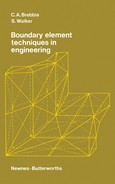
92 FUNDAMENTAL SOLUTIONS
and the eigenvalues are
K-±U-*¥
«c»
hence the fundamental solution for this region is
(
πη
4α
2
η=
^„κ
2
-(2π
2
η
2
/α
2
) "
r
~V
xexpf — (χ
2
-ξ
2
)) (d)
Note that now we have no trouble with the constant, n = 0, term, we
only get zeros in the denominator if κ
2
= 2π
2
η
2
/α
2
for some n.
4.4 INFINITE DOMAINS
We have seen that we may expand any function within a domain in
terms of a complete set of eigenfunctions orthonormal over the
domain by putting
00
u(x
l
,X
2
) = Σ *ηΦη (4.24)
n = - oo
The eigenfunctions depended on the coordinate system chosen and
the shape of the region.
If
we
now wish to represent a function over all space we cannot use
an expansion similar to (4.24), in this case we have to construct a set of
eigenfunctions normalised over all space. This set will now depend on
a continuously varying parameter jc, say, rather than just being
denoted by a discrete set of subscripts such as
n.
We shall denote these
eigenfunctions by φ(κ, χ). These functions will now depend only on
the coordinate system used, κ will be
a
vector with the same number of
components as 3c, i.e. in two dimensions the two components κ
ί9
κ
2
will correspond to the subscripts, η
γ
and n
2
in φ
η η
.
We shall see that in infinite space the summations will be replaced
by integrations and our discrete indices will be replaced by the now
continuously varying parameter κ.

FUNDAMENTAL SOLUTIONS 93
For our infinite region our orthonormalisation condition becomes
φ(κ, χ)φ(κ x)dx = (φ(κ, x), φ(κ x)
>^
= δ(κ-κ')
J all
space
(
425)
where the delta function is now the classical Dirac delta function
defined for all space, which is zero when κ Φ κ but infinite at κ = κ .
To define δ uniquely we require that
<φ(κ, 30, δ(κ-κ') >^= φ(κ χ) (4.26)
which is the replacement property of the delta function with respect to
our eigenfunctions. One consequence of (4.26) is that
<U(K-K')>^=1
(4.27)
This function is now expressed in terms of our eigenfunctions by,
δ(χ-ξ) = < Φ(κ, x), φ(κ
9
ξ) >. (4.28)
The brackets < >-now denote an integration over all /c space, i.e.
<0(κ,
χφ(κ,
ξ) >^= f φ(κ, ϊ)φ(κ, ξ)άκ (4.29)
J all
space
The expansion of any bounded function will now be given by
u(x) = <α(£), φ(κ
9
χ)}χ (4.30)
where by an argument similar to equations (4.13) to (4.16) we have
a(ie) = <φ(κ,χ), u(x)>
?
(4.31)
Equations (4.30) and (4.31) are a generalised transform pair.
If we now consider the expression corresponding to (4.17) for the
infinite domain
<«(*),
δ{χ-ξ)>; (4.32)
and expand both in terms of eigenfunctions we obtain
< < α(κ), φ(κ, x) >-, (φ(κ x), φ(κ ξ) >^ >^ (4.33)
assuming convergence of
the
integrals we may rearrange the above to
give

94 FUNDAMENTAL SOLUTIONS
< < (φ(Κ
9
*), φ(κ x) >^ , &(κ)φ(κ, ξ) >^ >
r
= <<<5(κ-κ'), α(κ)φ(κ'
9
ξ)}^
using (4.26)
=
(0L(K)
9
(S(K-K), φ(κ ?)>?}-*
= <α(κ), φ{κ,ξ)>ζ
using (4.27)
= M(f) by equation (4.31) (4.34)
Hence
<u(x),
i(x-{)>*=!<(£) (4.35)
This relation is fundamental in the boundary element method. We
shall illustrate the above points with an example.
Example 4.5
In one dimension or in Cartesian coordinates for an n-dimensional
space, we may choose (1/ yjln) e
kx
for our eigenfunctions, where κ
is
a
continuously varying parameter which will be
a
scalar variable for one
dimension. The constant 1/
λ
/2π appears as a result of the 'normali-
sation' condition given in equation (4.27).
Our delta function may now be written
S(x
~
0=
h
exp[i/c(x
— ξ)~]
άκ (a)
any bounded function of x can now be written
u{x)
'7^L
ü
^-
1KXdK
(b)
from equation (4.31), where
U(K)
is now the Fourier transform of u
and
U(K)
is given by
1
f
00
U(K)
= u(x)e
lKX
dx
J2n J-oo
(c)
Equations (b) and (c) now form a Fourier transform pair.
..................Content has been hidden....................
You can't read the all page of ebook, please click here login for view all page.
